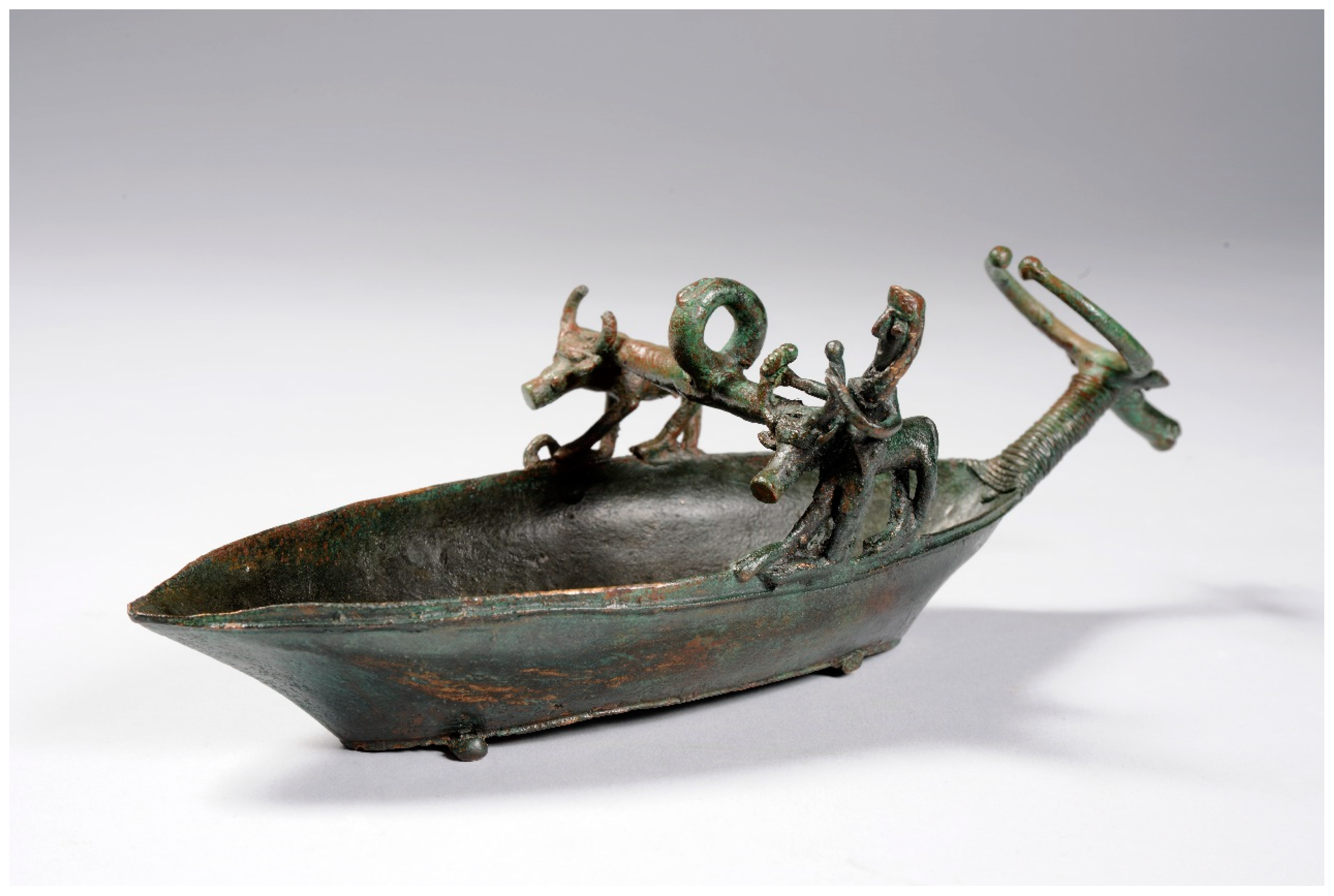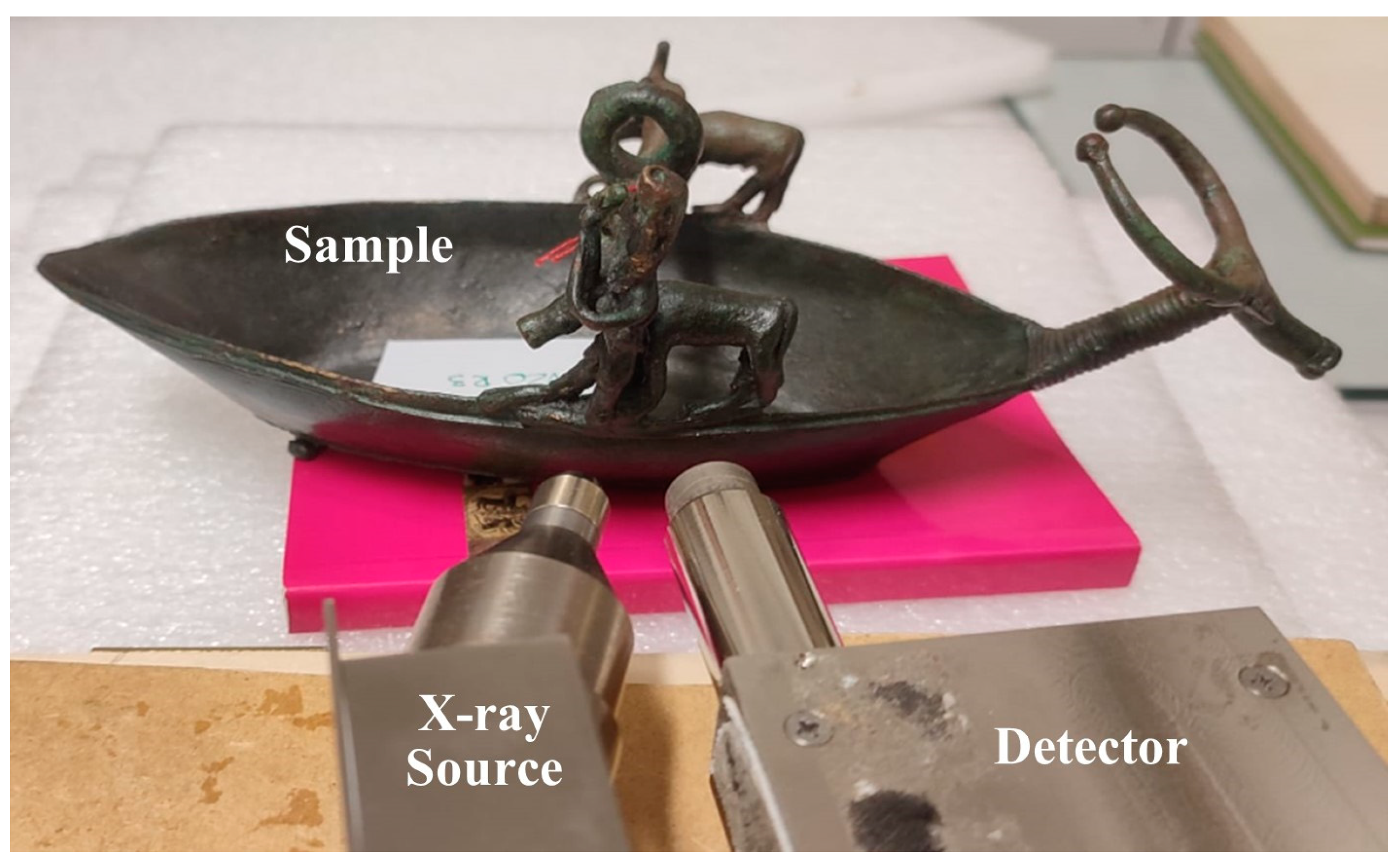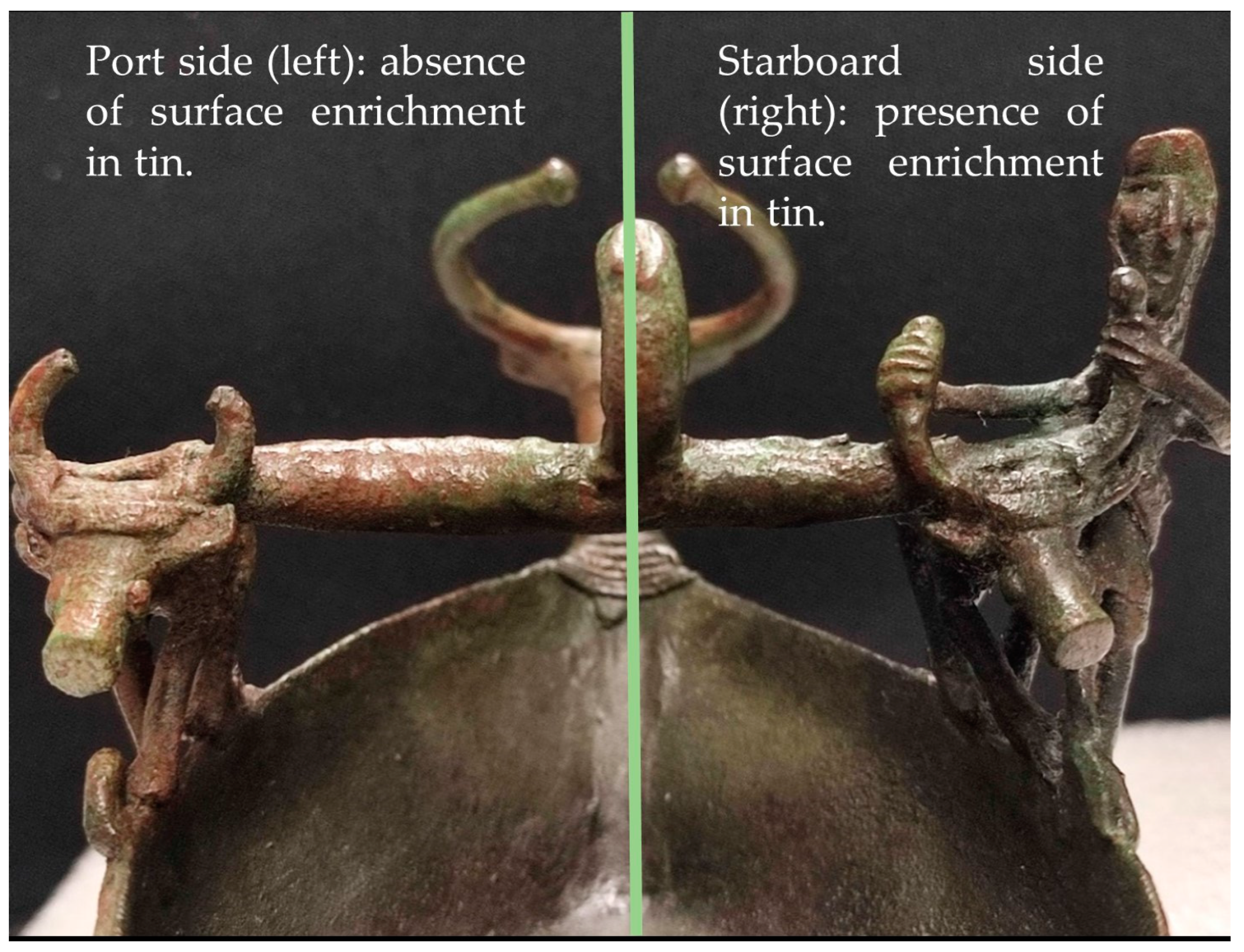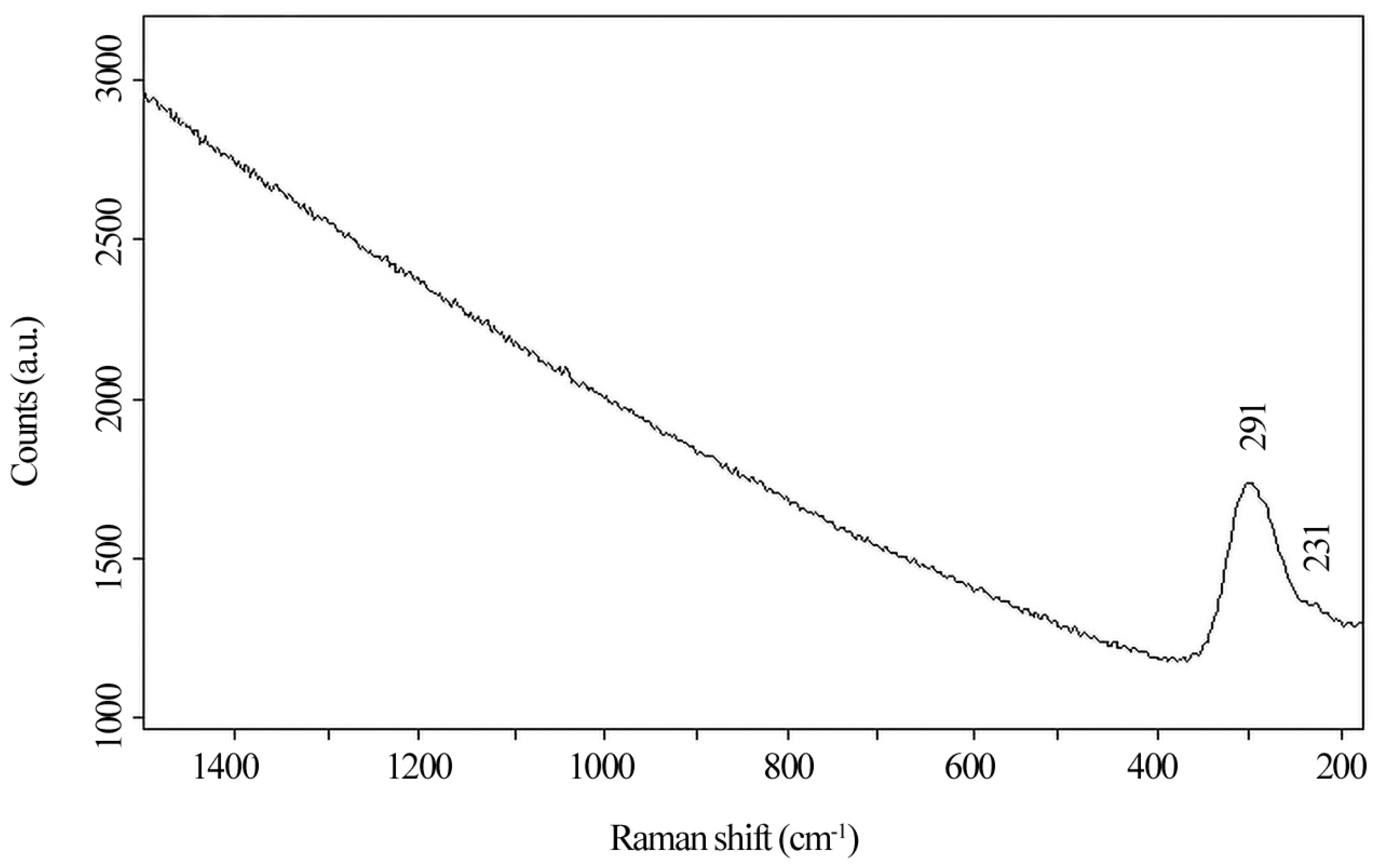Characterization of a Unique Nuragic Bronze Navicella with a Combination of X-ray Fluorescence Spectrometry and Monte Carlo Simulation
Abstract
:1. Introduction
2. Materials and Methods
- A simulation of the real measurement;
- Comparison between the simulated and measured spectra;
- If any differences above a preselected threshold (chi-squared test) are observed, the composition and/or the structure of the simulated sample is updated, and the simulation/comparison is repeated.
3. Results and Discussion
4. Conclusions
Author Contributions
Funding
Institutional Review Board Statement
Informed Consent Statement
Data Availability Statement
Conflicts of Interest
References
- Depalmas, A. Le Navicelle di Bronzo della Sardegna Nuragica; Ettore Gasperini Editore Società Poligrafica Sarda: Cagliari, Italy, 2005. [Google Scholar]
- Iannaccone, R.; Depalmas, A.; Bulla, C.; Augusto, S.; Lins, B.; Brunetti, A. Materials Characterisation of Alloy Composition of Protohistoric Small Boat Models from Sardinia (Italy). Materials 2022, 15, 1324. [Google Scholar] [CrossRef]
- Cesareo, R.; Brunetti, A. Metal sheets thickness determined by energy-dispersive X-ray fluorescence analysis. J. X-ray Sci. Technol. 2008, 16, 119–130. [Google Scholar]
- Bártová, H.; Trojek, T.; Johnová, K. Theoretical study of depth profiling with gamma- and X-ray spectrometry based on measurements of intensity ratios. Radiat. Phys. Chem. 2017, 140, 487–492. [Google Scholar] [CrossRef]
- Lopes, F.; Melquiades, F.L.; Appoloni, C.R.; Cesareo, R.; Rizzutto, M.; Silva, T.F. Thickness determination of gold layer on pre-Columbian objects and a gilding frame, combining pXRF and PLS regression. X-Ray Spectrom. 2016, 45, 344–351. [Google Scholar] [CrossRef]
- Cesareo, R.; Calza, C.; Anjos, M.D.; Lopes, R.T.; Bustamante; Alva, W. Pre-Columbian alloys from the royal tombs of Sipán; energy dispersive X-ray fluorescence analysis with a portable equipment. Appl. Radiat. Isot. 2010, 68, 525–528. [Google Scholar] [CrossRef] [PubMed]
- De Boer, D.K.G. Calculation of x-ray fluorescence intensities from bulk and multilayer samples. X-Ray Spectrom. 1990, 19, 145–154. [Google Scholar] [CrossRef]
- Sherman, J. The theoretical derivation of fluorescent X-ray intensities from mixtures. Spectrochim. Acta 1955, 7, 283–306. [Google Scholar] [CrossRef]
- Shiraiwa, T.; Fujino, N. Theoretical Calculation of Fluorescent X-Ray Intensities in Fluorescent X-Ray Spectrochemical Analysis. Jpn. J. Appl. Phys. 1966, 5, 886. [Google Scholar] [CrossRef]
- Solé, V.A.; Papillon, E.; Cotte, M.; Walter, P.; Susini, J. A multiplatform code for the analysis of energy-dispersive X-ray fluorescence spectra. Spectrochim. Acta Part B At. Spectrosc. 2007, 62, 63–68. [Google Scholar] [CrossRef]
- Elam, W.T.T.; Shen, R.B.; Scruggs, B.; Nicolosi, J. Accuracy of Standardless FP Analysis of Bulk and Thin Film Samples Using a New Atomic Database. Adv. X-ray Anal. 2004, 47, 104–109. [Google Scholar]
- Revenko, A.G.; Tsvetyansky, A.L.; Eritenko, A.N. X-ray fluorescence analysis of solid-state films, layers, and coatings. Radiat. Phys. Chem. 2022, 197, 110157. [Google Scholar] [CrossRef]
- Doster, J.M.; Gardner, R.P. The complete spectral response for EDXRF systems—Calculation by Monte Carlo and analysis applications. 1—Homogeneous samples. X-ray Spectrom. 1982, 11, 173–180. [Google Scholar] [CrossRef]
- Doster, J.M.; Gardner, R.P. The complete spectral response for EDXRF systems—Calculation by Monte Carlo and analysis applications. 2—Heterogeneous samples. X-ray Spectrom. 1982, 11, 181–186. [Google Scholar] [CrossRef]
- Brunetti, A.; Golosio, B.; Schoonjans, T.; Oliva, P. Use of Monte Carlo simulations for Cultural Heritage X-ray fluorescence analysis. Spectrochim. Acta Part B At. Spectrosc. 2015, 108, 15–20. [Google Scholar] [CrossRef]
- Pessanha, S.; Manso, M.; Antunes, V.; Carvalho, M.L.; Sampaio, J.M. Monte Carlo simulation of portable X-ray fluorescence setup: Non-invasive determination of gold leaf thickness in indo-Portuguese panel paintings. Spectrochim. Acta Part B At. Spectrosc. 2019, 156, 1–6. [Google Scholar] [CrossRef]
- Brunetti, A.; Porcaro, M.; Bustamante, A.; Stegel, G.; Cesareo, R. Combining X-ray Fluorescence and Monte Carlo Simulation Methods to Differentiate between Tumbaga and Gold-Alloy or Gildings. Materials 2022, 15, 4452. [Google Scholar] [CrossRef]
- Fernandez, J.E. Monte Carlo computer simulation of the XRF intensity dependence on the propagation plane inclination. Comput. Phys. Commun. 1989, 54, 211–220. [Google Scholar] [CrossRef]
- Vincze, L.; Janssen, K.; Adams, F. A general Monte Carlo simulation of energy-dispersive X-ray fluorescence spectrometers-I. Unpolarized radiation, homogeneous samples. Spectrochim. Acta Part B 1993, 48, 553–573. [Google Scholar] [CrossRef]
- Schoonjans, T.; Solé, V.A.; Vincze, L.; Del Rio, M.S.; Appel, K.; Ferrero, C. A general Monte Carlo simulation of energy-dispersive X-ray fluorescence spectrometers—Part 6. Quantification through iterative simulations. Spectrochim. Acta Part B 2013, 82, 36–41. [Google Scholar] [CrossRef]
- Golosio, B.; Schoonjans, T.; Brunetti, A.; Oliva, P.; Masala, G.L. Monte Carlo simulation of X-ray imaging and spectroscopy experiments using quadric geometry and variance reduction techniques. Comput. Phys. Commun. 2014, 185, 1044–1052. [Google Scholar] [CrossRef]
- Porcaro, M.; Depalmas, M.; Lins, S.; Bulla, C.; Pischedda, M.; Brunetti, A. Nuragic Working Tools Characterization with Corrosion Layer Determinations. Materials 2022, 15, 3879. [Google Scholar] [CrossRef] [PubMed]
- Sebar, L.E.; Iannucci, L.; Goren, Y.; Fabian, P.; Angelini, E.; Grassini, S. Raman investigation of corrosion products on Roman copper-based artefacts. Acta IMEKO 2020, 10, 129–135. [Google Scholar] [CrossRef]
- Veneranda, M.; Aramendia, J.; Gomez, O.; de Vallejuelo, S.F.-O.; Garcia, L.; Garcia-Camino, I.; Castro, K.; Azkarate, A.; Madariaga, J.M. Characterization of archaeometallurgical artefacts by means of portable Raman systems: Corrosion mechanisms influenced by marine aerosol. J. Raman Spectrosc. 2017, 48, 258–266. [Google Scholar] [CrossRef]
- Ospitali, F.; Chiavari, C.; Martini, C.; Bernardi, E.; Passarini, F.; Robbiola, L. The characterization of Sn-based corrosion products in ancient bronzes: A Raman approach. J. Raman Spectrosc. 2012, 43, 1596–1603. [Google Scholar] [CrossRef]
- Martens, W.; Frost, R.L.; Kloprogge, J.T.; Williams, P.A. Raman spectroscopic study of the basic copper sulphates—Implications for copper corrosion and ‘bronze disease. J. Raman Spectrosc. 2003, 34, 145–151. [Google Scholar] [CrossRef]
- He, T.; Gardner, R.P.; Verghese, K. An improved Si (Li) detector response function. Nucl. Instrum. Methods Phys. Res. Sect. A 1990, 299, 354–366. [Google Scholar] [CrossRef]
- Jehlička, J.; Culka, A.; Bersani, D.; Vandenabeele, P. Comparison of seven portable Raman spectrometers: Beryl as a case study. J. Raman Spectrosc. 2017, 48, 1289–1299. [Google Scholar] [CrossRef]
- Innocenti, S.; Balbas, D.Q.; Pezzati, L.; Fontana, R.; Striova, J. Portable Sequentially Shifted Excitation Raman Spectroscopy to Examine Historic Powders Enclosed in Glass Vials. Sensors 2022, 22, 3560. [Google Scholar] [CrossRef]
- Giumlia-Mair, A.R. The composition of copper-based small finds from a west phoenician settlement site and from nimrud compared with that of contemporary mediterranean small finds. Archaeometry 1992, 34, 107–119. [Google Scholar] [CrossRef]
- Ingo, G.M.; de Caro, T.; Riccucci, C.; Angelini, E.; Grassini, S.; Balbi, S.; Bernardini, P.; Salvi, D.; Bousselmi, L.; Çilingiroglu, A.; et al. Large scale investigation of chemical composition, structure and corrosion mechanism of bronze archeological artefacts from Mediterranean basin. Appl. Phys. A Mater. Sci. Process. 2006, 83, 513–520. [Google Scholar] [CrossRef]
- Di Turo, F.; Coletti, F.; De Vito, C. Investigations on alloy-burial environment interaction of archaeological bronze coins. Microchem. J. 2020, 157, 104882. [Google Scholar] [CrossRef]
- Bernabale, M.; Nigro, L.; Montanari, D.; Niveau-de-Villedary, A.M.; De Vito, C. Microstructure and chemical composition of a Sardinian bronze axe of the Iron Age from Motya (Sicily, Italy). Mater. Charact. 2019, 158, 109957. [Google Scholar] [CrossRef]
- Cano, E.; Lafuente, D. Corrosion inhibitors for the preservation of metallic heritage artefacts. In Corrosion and Conservation of Cultural Heritage Metallic Artefacts; Woodhead Publishing: Sawston, UK, 2013; pp. 570–594. [Google Scholar] [CrossRef]
- Argyropoulos, V.; Giannoulaki, M.; Michalakakos, G.P.; Siatou, A. A survey of the types of corrosion inhibitors and protective coatings used for the conservation of metal objects from museum collections in the Mediterranean basin. In Strategies for Saving our Cultural Heritage, Proceedings of the International Conference on Conservation Strategies for Saving Indoor Metallic Collections, Cairo, Egypt, 25 February–1 March 2007; Academic Press: Cambridge, MA, USA, 2007. [Google Scholar]
- Papadopoulou, O.; Vassiliou, P. The Influence of Archaeometallurgical Copper Alloy Castings Microstructure towards Corrosion Evolution in Various Corrosive Media. Corros. Mater. Degrad. 2021, 2, 227–247. [Google Scholar] [CrossRef]
- Robbiola, L.; Blengino, J.M.; Fiaud, C. Morphology and mechanisms of formation of natural patinas on archaeological Cu-Sn alloys. Corros. Sci. 1998, 40, 2083–2111. [Google Scholar] [CrossRef]
- Robbiola, L.; Portier, R. A global approach to the authentication of ancient bronzes based on the characterization of the alloy–patina–environment system. J. Cult. Herit. 2006, 7, 1–12. [Google Scholar] [CrossRef]
- Tylecote, R.F. The effect of soil conditions on the long-term corrosion of buried tin-bronzes and copper. J. Archaeol. Sci. 1979, 6, 345–368. [Google Scholar] [CrossRef]
- Soffritti, C.; Fabbri, E.; Merlin, M.; Garagnani, G.L.; Monticelli, C. On the degradation factors of an archaeological bronze bowl belonging to a private collection. Appl. Surf. Sci. 2014, 313, 762–770. [Google Scholar] [CrossRef]
- Mattei, E.; De Vivo, G.; De Santis, A.; Gaetani, C.; Pelosi, C.; Santamaria, U. Raman spectroscopic analysis of azurite blackening. J. Raman Spectrosc. 2008, 39, 302–306. [Google Scholar] [CrossRef]
- Scott, D.A.; Getty Conservation Institute. Copper and Bronze in Art: Corrosion, Colorants, Conservation; Getty Conservation Institute: Los Angeles, CA, USA, 2002; p. 515. [Google Scholar]







| Area | Copper (Cu wt%) | Tin (Sn wt%) | Lead (Pb wt%) |
|---|---|---|---|
| Right side (hull) | 89.9 | 7.7 | 2.2 |
| Left side (hull) | 88.6 | 8.0 | 3.2 |
| Hull bottom | 90.1 | 8.0 | 1.7 |
| Left animal | 94.8 | 3.2 | 1.9 |
| Right animal | 88.9 | 8.0 | 2.9 |
| Left bridge | 94.8 | 3.3 | 1.8 |
| Right bridge | 89.2 | 7.7 | 2.9 |
| Side of man | 90.5 | 7.0 | 2.3 |
| Ring | 88.4 | 8.8 | 2.6 |
| Left base protome | 90.4 | 6.9 | 2.5 |
| Head protome | 89.7 | 7.2 | 2.9 |
Disclaimer/Publisher’s Note: The statements, opinions and data contained in all publications are solely those of the individual author(s) and contributor(s) and not of MDPI and/or the editor(s). MDPI and/or the editor(s) disclaim responsibility for any injury to people or property resulting from any ideas, methods, instructions or products referred to in the content. |
© 2023 by the authors. Licensee MDPI, Basel, Switzerland. This article is an open access article distributed under the terms and conditions of the Creative Commons Attribution (CC BY) license (https://creativecommons.org/licenses/by/4.0/).
Share and Cite
Porcaro, M.; Lins, S.; Depalmas, A.; Anzalone, R.M.; Iannaccone, R.; Brunetti, A. Characterization of a Unique Nuragic Bronze Navicella with a Combination of X-ray Fluorescence Spectrometry and Monte Carlo Simulation. Materials 2023, 16, 7345. https://doi.org/10.3390/ma16237345
Porcaro M, Lins S, Depalmas A, Anzalone RM, Iannaccone R, Brunetti A. Characterization of a Unique Nuragic Bronze Navicella with a Combination of X-ray Fluorescence Spectrometry and Monte Carlo Simulation. Materials. 2023; 16(23):7345. https://doi.org/10.3390/ma16237345
Chicago/Turabian StylePorcaro, Marta, Sergio Lins, Anna Depalmas, Rosario Maria Anzalone, Roberta Iannaccone, and Antonio Brunetti. 2023. "Characterization of a Unique Nuragic Bronze Navicella with a Combination of X-ray Fluorescence Spectrometry and Monte Carlo Simulation" Materials 16, no. 23: 7345. https://doi.org/10.3390/ma16237345
APA StylePorcaro, M., Lins, S., Depalmas, A., Anzalone, R. M., Iannaccone, R., & Brunetti, A. (2023). Characterization of a Unique Nuragic Bronze Navicella with a Combination of X-ray Fluorescence Spectrometry and Monte Carlo Simulation. Materials, 16(23), 7345. https://doi.org/10.3390/ma16237345







